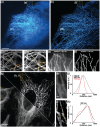hydro SIM: super-resolution speckle illumination microscopy with a hydrogel diffuser
- PMID: 38867780
- PMCID: PMC11166422
- DOI: 10.1364/BOE.521521
hydro SIM: super-resolution speckle illumination microscopy with a hydrogel diffuser
Abstract
Super-resolution microscopy has emerged as an indispensable methodology for probing the intricacies of cellular biology. Structured illumination microscopy (SIM), in particular, offers an advantageous balance of spatial and temporal resolution, allowing for visualizing cellular processes with minimal disruption to biological specimens. However, the broader adoption of SIM remains hampered by the complexity of instrumentation and alignment. Here, we introduce speckle-illumination super-resolution microscopy using hydrogel diffusers (hydroSIM). The study utilizes the high scattering and optical transmissive properties of hydrogel materials and realizes a remarkably simplified approach to plug-in super-resolution imaging via a common epi-fluorescence platform. We demonstrate the hydroSIM system using various phantom and biological samples, and the results exhibited effective 3D resolution doubling, optical sectioning, and high contrast. We foresee hydroSIM, a cost-effective, biocompatible, and user-accessible super-resolution methodology, to significantly advance a wide range of biomedical imaging and applications.
© 2024 Optica Publishing Group.
Conflict of interest statement
The authors declare that there are no conflicts of interest in this article.
Figures





Similar articles
-
Real-time super-resolution structured illumination microscopy: current progress in joint space and frequency reconstruction.Rep Prog Phys. 2025 Jul 7. doi: 10.1088/1361-6633/adecb1. Online ahead of print. Rep Prog Phys. 2025. PMID: 40623425
-
Multimodal illumination platform for 3D single-molecule super-resolution imaging throughout mammalian cells.Biomed Opt Express. 2024 Apr 16;15(5):3050-3063. doi: 10.1364/BOE.521362. eCollection 2024 May 1. Biomed Opt Express. 2024. PMID: 38855669 Free PMC article.
-
Novel application of metabolic imaging of early embryos using a light-sheet on-a-chip device: a proof-of-concept study.Hum Reprod. 2025 Jan 1;40(1):41-55. doi: 10.1093/humrep/deae249. Hum Reprod. 2025. PMID: 39521726 Free PMC article.
-
Cellular optical imaging techniques: a dynamic advancing frontier.Sci China Life Sci. 2025 Jul 16. doi: 10.1007/s11427-024-2916-5. Online ahead of print. Sci China Life Sci. 2025. PMID: 40681818 Review.
-
Expansion and fluctuations-enhanced microscopy for nanoscale molecular profiling of cells and tissues.Nat Protoc. 2025 Jul 2. doi: 10.1038/s41596-025-01178-0. Online ahead of print. Nat Protoc. 2025. PMID: 40604265 Review.
Cited by
-
Fluorescence microscopy through scattering media with robust matrix factorization.Cell Rep Methods. 2025 May 19;5(5):101031. doi: 10.1016/j.crmeth.2025.101031. Epub 2025 Apr 28. Cell Rep Methods. 2025. PMID: 40300606 Free PMC article.
References
Grants and funding
LinkOut - more resources
Full Text Sources
